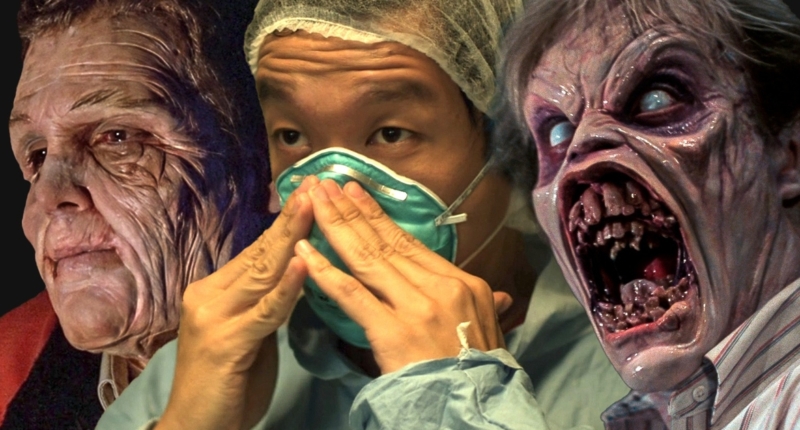Encephalitis, an inflammation of the brain or spinal cord, can cause symptoms like disorientation and hallucinations similar to those experienced by the protagonist in the TV show “Hannibal.” Hannibal suspects the protagonist has the condition and doesn’t tell him, leading to a tense situation. Encephalitis can lead to permanent brain damage if not treated quickly, making it a serious condition.
In “The Last of Us” video game and HBO TV series, the “zombie-like” Infected are inspired by the Cordyceps fungus, which can infect and hijack insects’ bodies to spread its spores. While this fungus is not transmissible to humans, experts warn that being prepared for unexpected pathogens is essential as the Earth’s climate changes.
If someone needs help with mental health, there are resources available, including the Crisis Text Line, the National Alliance on Mental Illness helpline, and the National Institute of Mental Health website.
Progeroid syndromes are rare genetic disorders that mimic the effects of aging, affecting hair growth, height, skin, heart, and joint health in ways that are similar to the natural aging process. People with these disorders typically do not live long, and studying them can provide insight into the aging process and lead to medical breakthroughs.
Keywords: encephalitis, Cordyceps fungus, mental health, progeroid syndromes, aging.
Terrifying Real-Life Diseases Featured in Movies and TV Shows
Some of our favorite movies and television shows often depict terrifying diseases, viruses, disorders, and other medical conditions. Interestingly, many of these illnesses are not just figments of the writer’s imagination, but are based on real-world examples.
Despite the ongoing COVID-19 pandemic, people are gradually becoming more interested in stories about illness, loss, and the moral complexities of life on Earth. The success of HBO’s adaptation of the hit post-apocalyptic survival game “The Last Of Us” is a clear indication of this trend.
Plenty of movies and TV series explore medical maladies, but they differ greatly in scientific accuracy. However, they offer valuable insight into our relationship with the forces of nature and science.
In this article, we’ll look at some remarkable and terrifying examples of medical conditions that seem like they were created by a Hollywood writer. However, as the saying goes, truth can be stranger than fiction.
One such example is the horror movie “Cabin Fever,” directed by Eli Roth, in which a group of college students on a weekend trip to a cabin in the woods encounter irate locals and a highly infectious flesh-eating disease. The movie was inspired by Roth’s personal experience with skin infection while working on a horse farm as a teenager. While the movie is a gruesome and trashy flick, the disease depicted in it, necrotizing fasciitis, is a real and serious life-threatening skin infection.
Necrotizing fasciitis is a rare but aggressive skin infection that spreads rapidly through muscle and kills off surrounding tissue. If certain strains of bacteria, such as streptococci or staphylococcus, find their way into an open wound on your body, you’re at risk of developing this condition. It’s incredibly painful, takes only days to wreak havoc, and isn’t always obvious in its early stages.
While “Cabin Fever” does not explicitly identify the disease, there’s an obvious real-life parallel. It is a cautionary tale of the importance of taking good care of our bodies and being mindful of the risks associated with open wounds.
In conclusion, movies and TV shows may not always be entirely accurate in their depiction of medical conditions, but they offer a unique perspective on how we perceive and deal with disease and other maladies in our daily lives.
Fact-Based Medical Conditions That Inspired Popular Movies
Movies have long been known for their ability to transport us to a different world and make us forget about our problems. However, even though some films require a bit of suspension of disbelief, it is still important to pay attention to the facts. Some of the best movies are those that are grounded in reality and have been extensively researched.
One such movie is “Contagion,” a disaster thriller that follows the spread of the MEV-1 pandemic. While MEV-1 is a fictional virus, it was created with the help of experts, including journalist Laurie Garrett and Columbia University’s W. Ian Lipkin. The virus and the science behind it frighteningly resembles the Nipah virus, which has broken out numerous times since 1999. The movie not only depicts how viruses function but also shows how scientists react and respond to infectious diseases. It received high praise from experts upon release and sadly proved prescient when the COVID-19 pandemic occurred.
In contrast, “Cabin Fever” is a horror movie that depicts a group of college students encountering a flesh-eating disease. While the movie is a gruesome and trashy flick, the disease depicted in it, necrotizing fasciitis, is a real and serious life-threatening skin infection. Even if detected quickly, treatment of necrotizing fasciitis typically requires major surgery to remove all the infected tissue, meaning weeks or even months of intense nursing care and skin grafts. The movie serves as a cautionary tale of the importance of taking good care of our bodies and being mindful of the risks associated with open wounds.
Lastly, the “Evil Dead” franchise is known for its possessed limbs, a concept that has medical precedent. While Natalie’s self-surgery with an electric carving knife in the 2013 “Evil Dead” is horrifying, Ash Williams’ slapstick battle with his own hand in “Evil Dead 2” is equally memorable. However, seemingly possessed limbs are not just relegated to horror movies. In reality, conditions such as alien hand syndrome and phantom limb syndrome can cause limbs to move involuntarily or feel as though they are present even after amputation.
In conclusion, movies may not always be entirely accurate in their depiction of medical conditions, but they offer a unique perspective on how we perceive and deal with disease and other maladies in our daily lives. The best movies are those that are grounded in reality and have been thoroughly researched, and these three movies are great examples of how fact-based fiction can be both entertaining and informative.
The Real-Life Medical Conditions That Inspired Movies
Movies are known for their ability to capture our imagination and take us to a different world. However, some films are grounded in reality and have been inspired by real medical conditions. Here are a few examples of such movies.
Alien Hand Syndrome
In “Evil Dead 2,” Ash Williams famously battles his possessed hand with a chainsaw. While the concept of a possessed limb is the stuff of horror movies, the reality of “alien hand syndrome” is a medical condition that has been studied for over a century. Symptoms include involuntary movement and the grasping of random objects. It typically manifests following a stroke, epilepsy surgery, or as a result of neurodegenerative conditions affecting areas of the brain responsible for our motor skills.
Multiple Chemical Sensitivity Syndrome
In “Safe,” Julianne Moore plays a Los Angeles housewife who experiences inexplicable bouts of chemical-related illness and seeks refuge within an isolated community. The mysterious syndrome is inspired by tabloid stories about “20th-century disease” and the experiences of those living with HIV/AIDS. In the real world, it’s a condition that has been observed and studied for decades, typically as “multiple chemical sensitivity syndrome” or MCS. Symptoms range from changes in mood and cognitive function to anxiety and depression, and others across the immune, endocrine, and nervous systems.
Necrotizing Fasciitis
In “Cabin Fever,” a group of college students encounter a flesh-eating disease while renting a cabin in the woods. While the movie is a gruesome and trashy flick, the disease depicted in it, necrotizing fasciitis, is a real and serious life-threatening skin infection. Even if detected quickly, treatment of necrotizing fasciitis typically requires major surgery to remove all the infected tissue, meaning weeks or even months of intense nursing care and skin grafts.
In conclusion, while movies may not always be entirely accurate in their depiction of medical conditions, they offer a unique perspective on how we perceive and deal with disease and other maladies in our daily lives. These three movies are great examples of how fact-based fiction can be both entertaining and informative.
Hairworms and Toxoplasmosis: The Real-World Horrors
The idea of an airborne toxin driving its victims to mass suicide is a frightening one, but nature has cooked up some nasty parallels. Invertebrates like crickets and grasshoppers are often the victims of nematomorpha or hairworms. This parasite forces its way into their bodies and influences them to seek out submersion, essentially drowning themselves. Although hairworms do not affect vertebrates, they are one of the real-world horrors.
In humans, Toxoplasma gondii is a common parasite believed to be chronically present in up to one-third of the world’s population. Although most people will not experience symptoms associated with toxoplasmosis, studies have linked inflammation caused by latent toxoplasmosis to psychiatric issues, including depression, schizophrenia, and even suicidal behavior.
M. Night Shyamalan’s 2008 survival horror film “The Happening” was not well-received by critics. Still, the airborne toxin driving its victims to suicide in the movie is similar to real-world parasites. Despite their horror-movie-like symptoms, hairworms and toxoplasmosis offer insight into what happens when parasites hijack their host’s nervous systems.
In 2021, the INSPQ published an extensive analysis of more than 4,000 scientific articles concerning Multiple Chemical Sensitivity (MCS). The report concluded that the nature of MCS is likely psychological rather than biological: severe anxiety stemming from a perceived sensitivity to chemicals. Nevertheless, the condition still impacts the day-to-day lives of those experiencing it, warranting further study and treatment of patients. Todd Haynes’ movie, “Safe,” may be a work of fiction, but it still offers valuable insight into what it means to be sick.
Medical Anomalies That Have Real-World Parallels
From accelerating aging to rare genetic disorders, the world of medical anomalies offers intriguing cases for scientists to study. While some of these phenomena may seem otherworldly, science offers plausible explanations for each. Here’s a closer look at some of the most fascinating medical anomalies and the real-world parallels that help explain them.
Progeroid Syndromes: Accelerated Aging
Progeroid syndromes are rare genetic disorders that mimic the effects of aging on the body. Hutchinson-Gilford progeria syndrome, Werner syndrome, and other disorders affect hair growth, height, skin, heart, and joint health. However, unlike normal aging, these conditions result from a mutation within the body’s genes. Consequently, people with accelerated aging syndromes don’t survive very long due to heart disease and their body’s decreased ability to carry out regular cell repair.
Despite the grim prognosis, progeroid syndromes remain a hotbed of research and study. Scientists believe that advances in treatment for progeroid syndromes will not only improve the lives of those living with them but will open the door to further breakthroughs in understanding the human aging process as a whole.
Encephalitis: The Reality Behind Hannibal’s Disease
NBC’s “Hannibal” television series featured a lot of strange and nasty body stuff, including the inclusion of encephalitis. Unlike many of the other strange phenomena depicted in the series, encephalitis has a basis in reality.
Encephalitis is inflammation of the brain, usually caused by a viral infection. Symptoms can include headache, fever, confusion, seizures, and even hallucinations. In severe cases, it can be life-threatening. While the depiction of encephalitis in “Hannibal” may have been stylized for dramatic effect, the reality of the disease is no less disturbing.
Real-World Accelerated Aging
In the show’s second season, “The X-Files” sends FBI agents Mulder and Scully to the Norwegian Sea, where a U.S. military vessel and its crew appear to have aged rapidly with no explanation. While writers Howard Gordon and Alex Gansa took liberties with the science of accelerated aging, the concept has its roots in the rational.
Contaminated seawater can cause rapid oxidation of the body’s cells and hypernatremia, a condition in which the body contains too much salt. Medical conditions that mimic the effects of human aging are broadly labeled “progeroid syndromes,” rare genetic disorders that include Hutchinson-Gilford progeria syndrome, Werner syndrome, and others.
Conclusion
While medical anomalies may seem strange and otherworldly, science offers plausible explanations for each. Researchers continue to study these conditions to improve our understanding of the human body and advance medical treatment. If you or someone you know needs help with mental health, please seek professional assistance.
The Real-Life Medical Conditions That Inspired TV and Video Game Nightmares
Television shows and video games often depict medical conditions and diseases to add a level of terror and anxiety to their stories. However, some of these depictions are based on real-life medical conditions and diseases that can be just as terrifying.
Encephalitis, the condition that plagued Will Graham
In the television series “Hannibal,” FBI criminal profiler Will Graham experiences bizarre hallucinations and disorientation caused by advanced encephalitis. Encephalitis is a condition where inflammation in the brain or spinal cord can lead to the body’s immune system reacting to itself, resulting in symptoms not dissimilar to those experienced by Graham. The clock-drawing test taken by Graham is used by clinicians to detect conditions, including encephalitis, Alzheimer’s disease, and even high blood pressure. Encephalitis can lead to permanent brain damage if not treated quickly, which makes the depiction in “Hannibal” all the more disturbing.
The Real-Life Fungal Infection Behind “The Last of Us”
“The Last of Us” is a popular post-apocalyptic video game that features zombie-like Infected caused by the Cordyceps fungus. The game’s developers were inspired by the “zombie-ant fungus” Ophiocordyceps unilateralis, which is a real-life fungus that infects ants by breaching their exoskeleton, enveloping and splitting their muscle tissue, and hijacking their bodies upon death to continue spreading its spores. This fungus is just one of many species of Cordyceps existing in nature.
Seeking Help for Mental Health
It is essential to seek help if you or someone you know is struggling with mental health. The Crisis Text Line and the National Alliance on Mental Illness helpline provide support to those in need. The National Institute of Mental Health website is also an excellent resource for finding help.
Cordyceps Fungus: Biting Behavior and the “Death Grip”
Cordyceps, the fungus behind the zombie-like Infected in “The Last of Us” franchise, employs biting behaviors to increase its transmission rate. Known as the “death grip,” these behaviors allow the ant’s body to spread cordyceps spores, ensuring the fungus’s spread. While humans need not worry about Cordyceps transmission, experts warn that the Earth’s changing climate increases the likelihood of fungal pathogens spreading. Yale School of Medicine’s Scott Roberts suggests preparedness is key.
Don’t miss interesting posts on Famousbio









